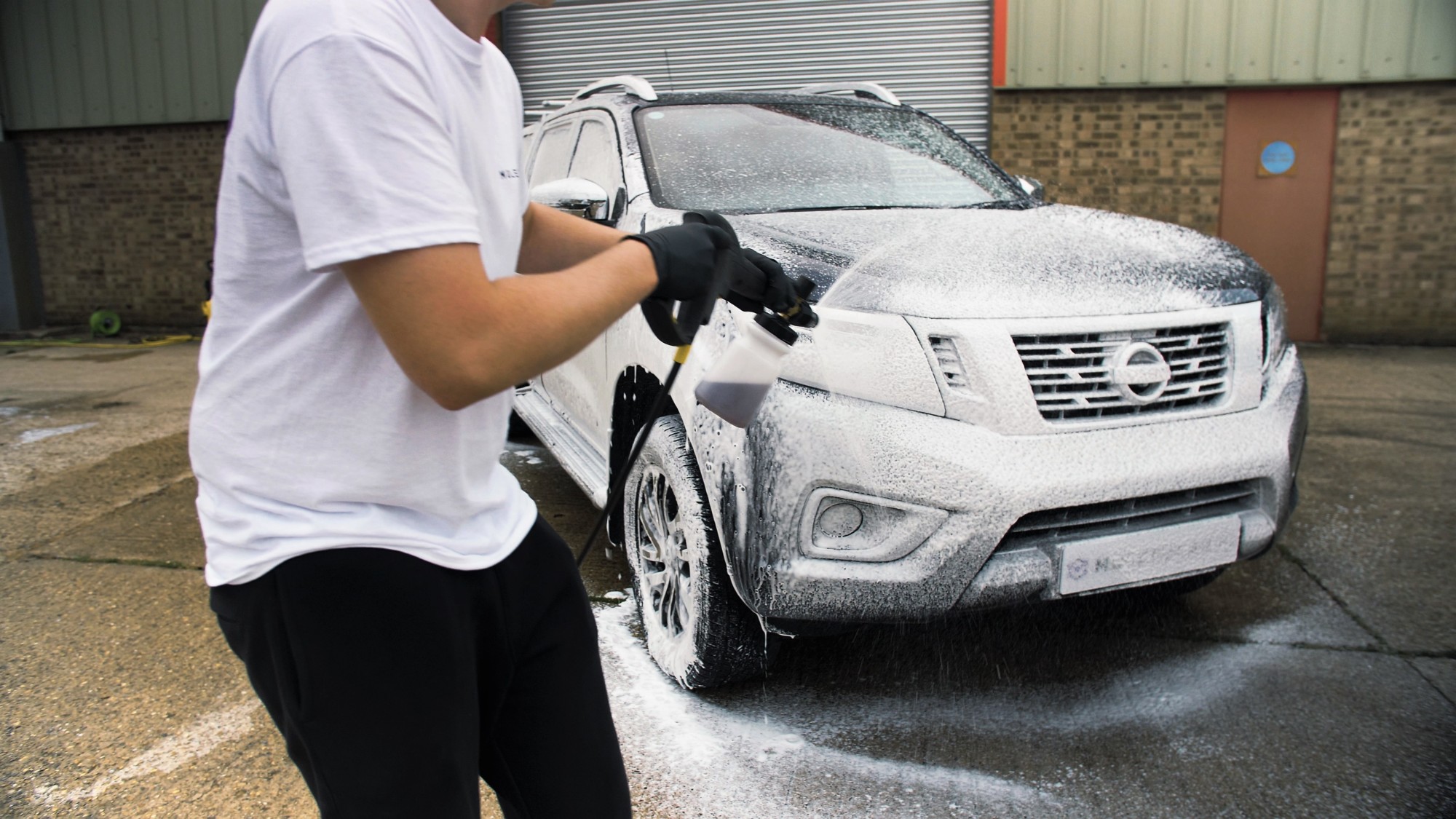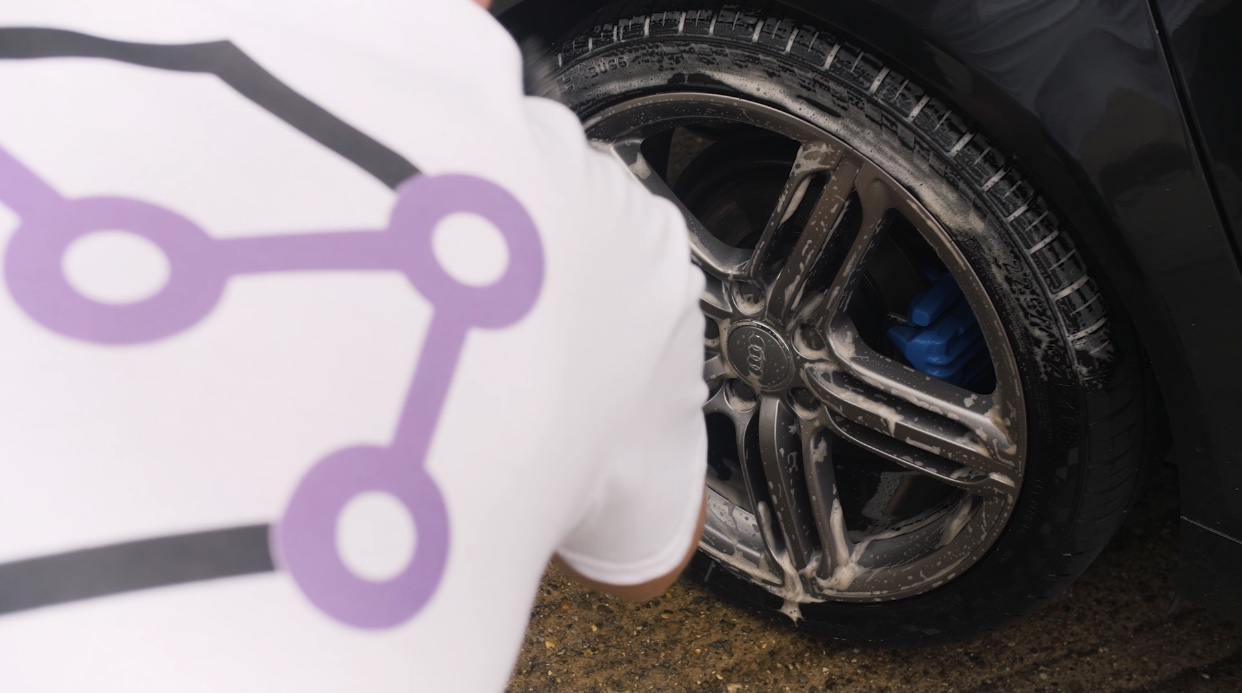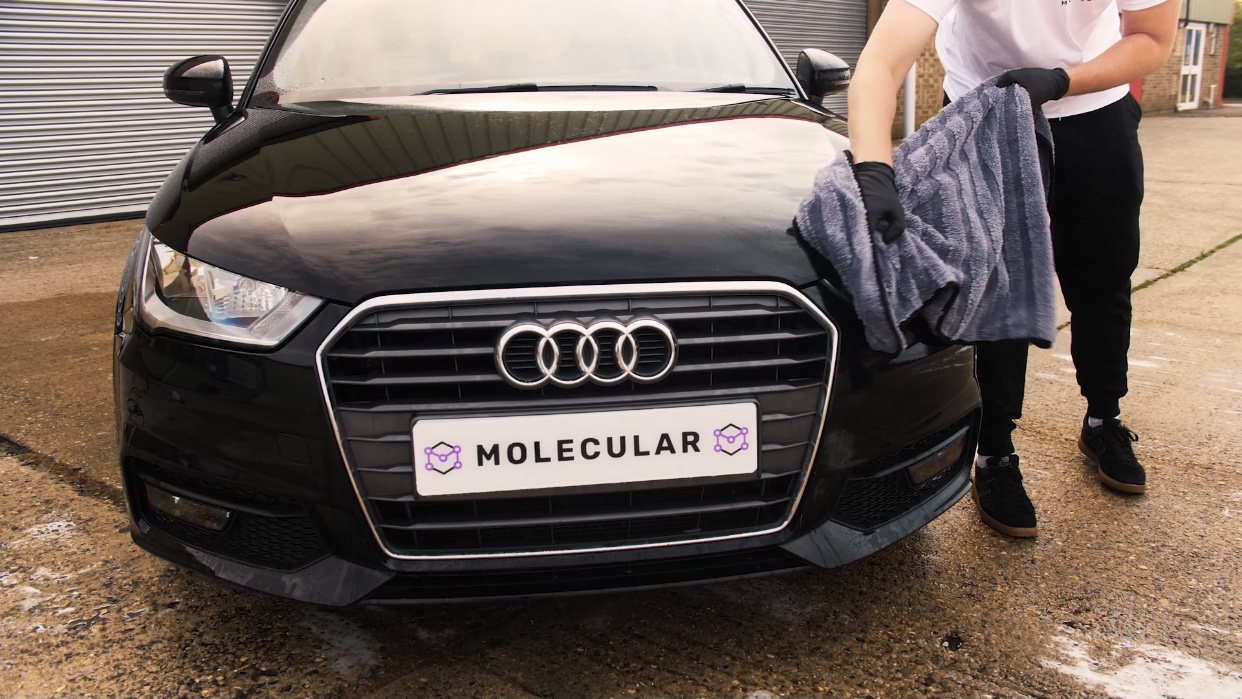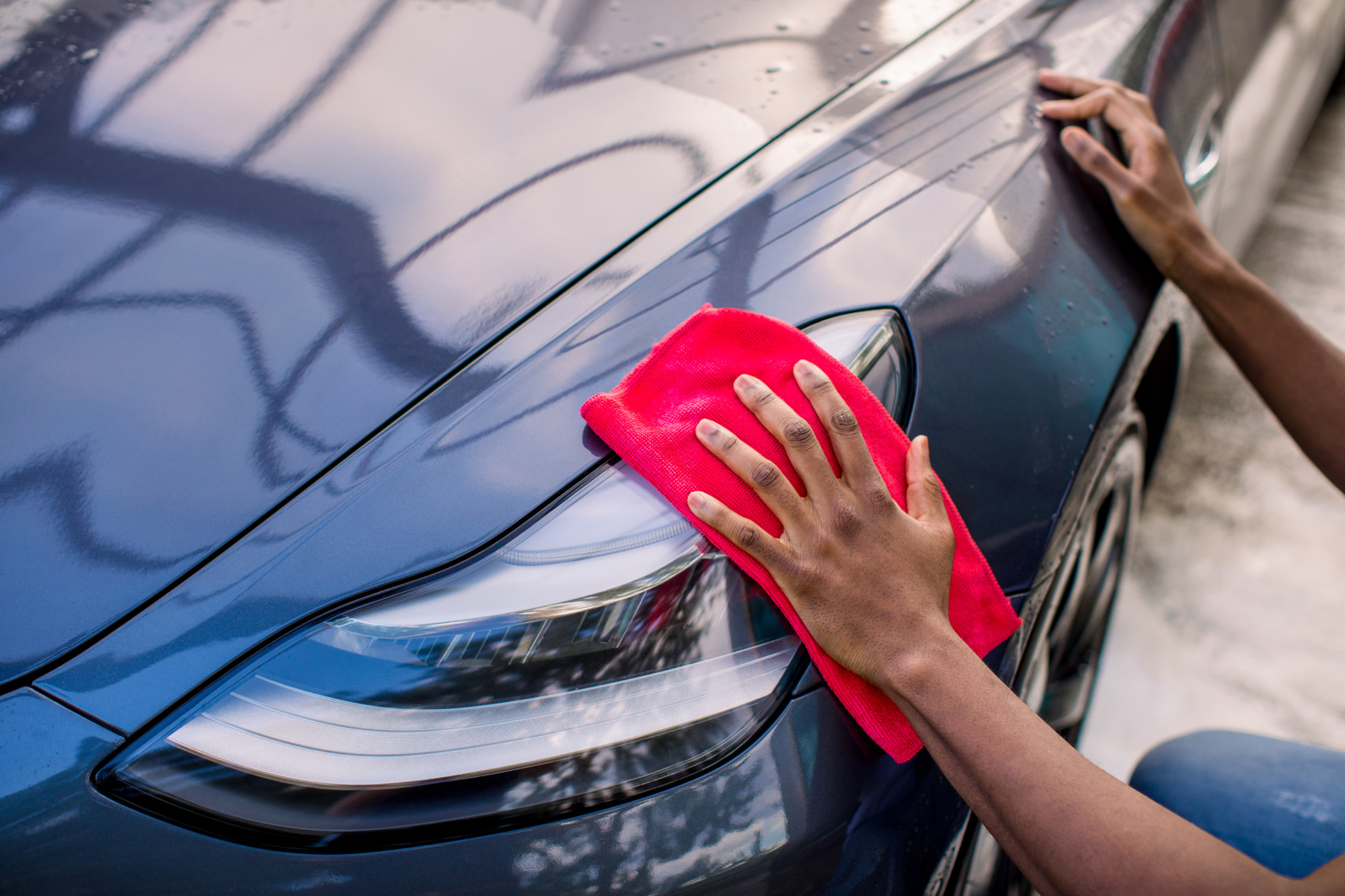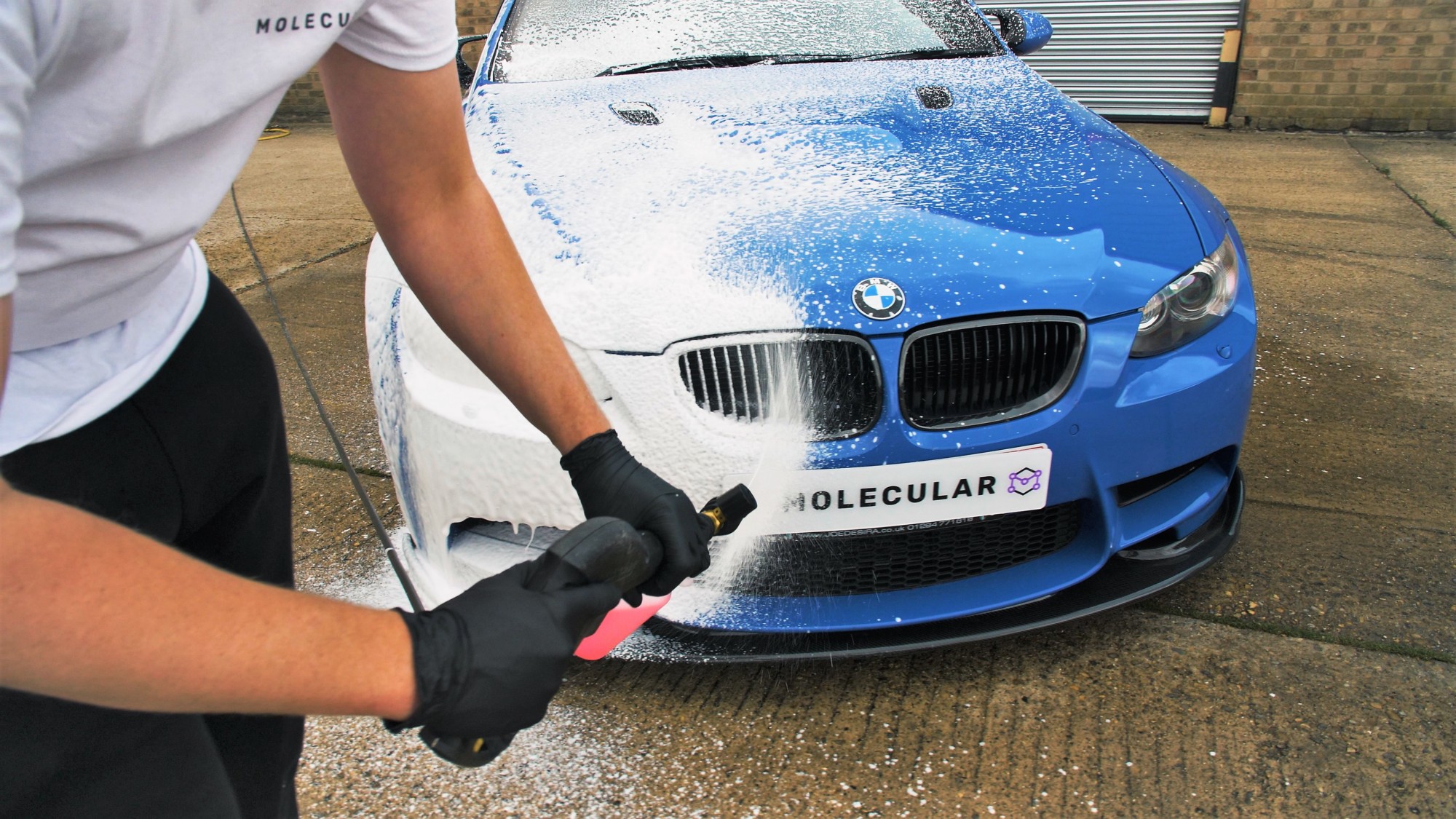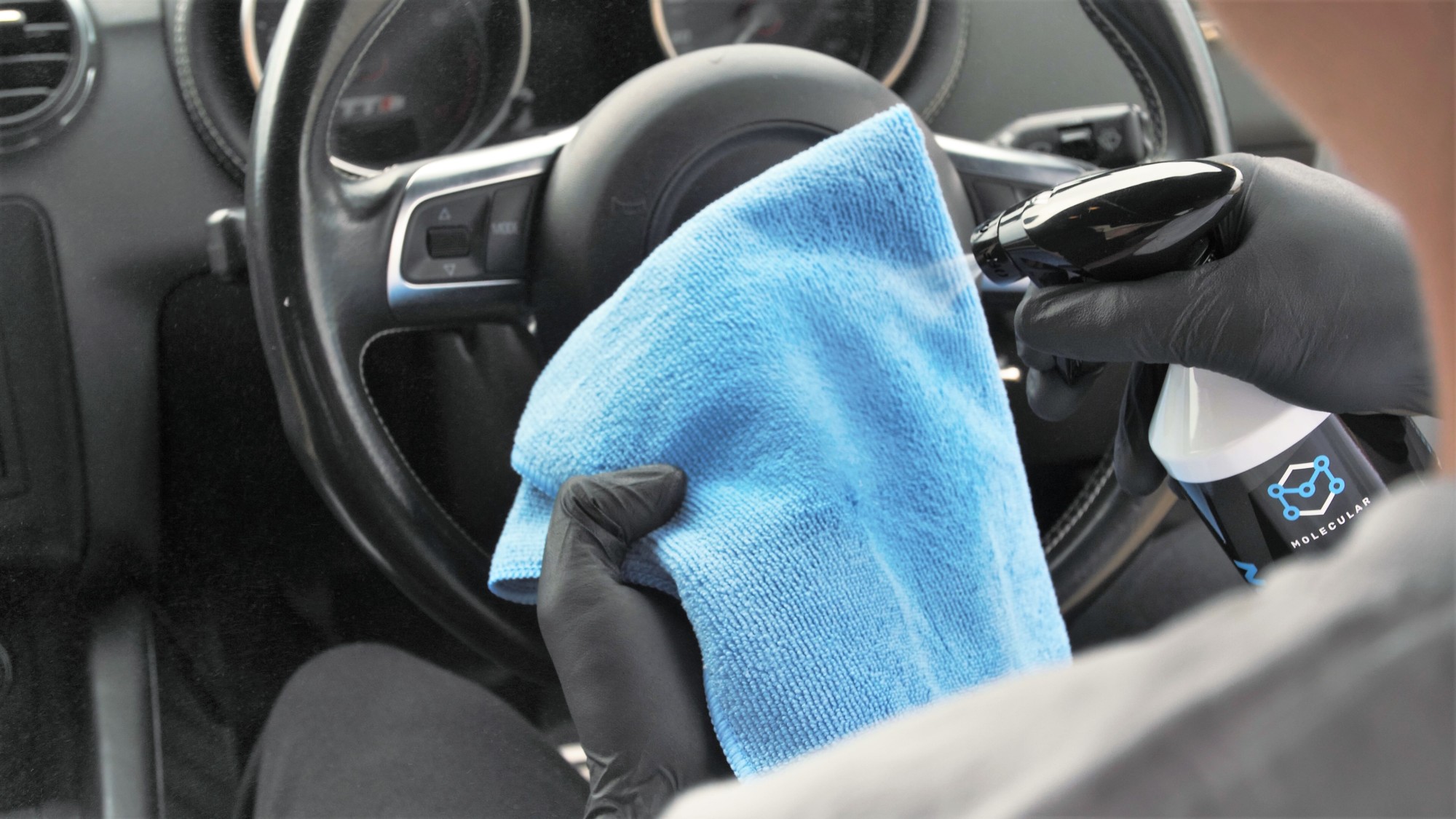What is TFR?
All vehicles, big or small, are exposed to contaminants every day. Things like bird droppings, tar, dirt, mud and dust will all fall and stick to your vehicle at some point. If you are someone, like us, who use their car every day you will realise that all these contaminants combine onto your vehicle body work, creating a slight grey looking film that not only sticks to the vehicle, but can be extremely hard to get off. This is called traffic film. Not only is it just the contaminants that were mentioned above, but you would be surprised at the number of other contaminants that are classed as traffic film. Even sand, iron, soot, carbon deposits, grease, tree sap you name it, they are all classed as traffic film.
If you clean your vehicle regularly you will know how hard it can be to remove these contaminants that we refer to as traffic film. There are so many great options we have that are brilliant at removing traffic film, from Big Bang citrus pre-wash to Cyclone snow foam, but the best type of product for the job would be a TFR.
TFR stands for traffic film remover, and it does exactly what the name suggests. There are so many different traffic films out there on the market these days, from TFR with added rinse aids to high foaming TFRs even to low foaming TFRs, you name it, there’s loads. We have been manufacturing a wide variety of TFRs for over 40 years so there would not be a TFR we haven’t come across. Our TFRs are unique, however.
We have been carefully formulating and mastering these different ranges of TFRs over the years and are proud to finally offer these great products to you. Whether it be a mild TFR that won’t be harmful to your car body work to use at home, or a high quality strong TFR to remove all the traffic film from your lorry that has been on the road for weeks, below we will select 5 different TFRs we make and detail it’s benefits and it’s be intended use.
G-FORCE – High Active TFR
Titan is probably one of our favourite and most popular TFRs. It is strong enough to remove all traffic film from your vehicle, but when diluted properly, will not be harmful to your paintwork. This unique TFR is mainly for use in conjunction with a high pressure cleaning system (or pressure washer) but can also be diluted into a low pressure spray before application. The best thing about this great product is that not only does it cut through and dissect the traffic film, but it also leaves a surprisingly vibrant shine. Whether you intend to use Titan for your HGV lorry or your home vehicle, simply dilute to the strength you require and blast away!
GRAUPEL– High Foaming TFR
You are probably well aware of snow foam. Lather your vehicle in foam, or “snow”, and watch the product break down and loosen all the dirt then wash off without having to agitate it. Well wouldn’t it be great to make that into a TFR for use on HGV’s? Look no further than Graupel. This high active, high foaming TFR smothers your vehicle in foam and as it clings to the bodywork, all the materials we put inside the solution help to breakdown and remove traffic film without agitation.
NEU-PRO – Neutral pH TFR
If you are a little apprehensive about using a TFR on your vehicle because of the slight chance of damaging your paintwork, then Neutron is the product for you. This great TFR is great for use as a beginner as it is neutral pH, meaning there’s not a lot in there that can affect your vehicle. Don’t worry though, it has still been specially formulated so you still get great washing power from it. This product is so good that it foams up nicely, spreading the solution over a greater area so you have much better coverage. Not only does this Neutron clean brilliantly, removing oil and grease, it also helps maintain your vehicles great paintwork shine and is safe to use on ceramic coatings.
LEGION – Multi-Purpose TFR
Legion is one of, if not the most popular TFR in our range. Not only is it a really high quality product, but it’s not going to break the bank either. This awesome product is mainly for use in conjunction with high pressure cleaning systems (pressure washers) and can also be applied via low pressure spray. Not only is Universal great at cleaning your bodywork, but it also makes a chassis cleaner & degreaser. So if you are looking for a great, cost effective TFR to use on your fleet then Universal is the product for you.
TILT CLEAN – Heavy Duty TFR & Degreaser
The last TFR on the list has to be one of the strongest and toughest TFRs on the range. This truly amazing formulation is suitable for any cleaning task, it not only removes traffic film, but can also be used as a degreaser and tough sanitiser. Tilt Clean is an excellent TFR for MOT & HGV curtain washing, along with cleaning alloy wheels & aluminium as well. Due it’s strength and the added biocidal agents we have infused into the formulation, Molecular HS is a great sanitiser for food & farming cleaning, removing fats, proteins, blood and other contaminants.
DIY is better than finding a car wash, here is why
With hand car washes popping up all over the place, the temptation to go get your car quickly washed while you wait is an appeal. We’re here to tell you why you shouldn’t, and you should be doing it yourself;
Fresh water isn’t always used;
The large buckets of water you see being used tends to be the same bucket of water that was used to clean the filthy, off road 4×4 that went before your vehicle. If you want your car washed with dirt this is definitely a great way. We always recommend the two bucket method with a microfibre wash mitt.
There are many ways to dry a car badly;
Hand car washes don’t tend to use microfibre towels, instead they use chamois leathers which tend to have a similar problem to sponges with regards to trapping grit and then dragging it around. When you also consider that they are rarely rinsed out and normally just wrung out the probability of being contaminated with dirt is high.
You know your products;
Most importantly, when you do it yourself you know exactly what chemical are going on to your car. Cheaper chemicals can cause issues to the paintwork. Hand car washes tend to use a dilute of traffic film remover which if used properly can be OK but tend to spray the whole car with it with little regard to prior wax protection meaning your paintwork is exposed to day to day wear and the elements. Along with this we have also seen damaged chrome, plastic and rubber trim from this process.
You get to know your car;
You gain an understanding of your car, the paintwork and finishing. Having these insights allows you to take preventative measures before they become a real issue. For example; washing the car yourself and noticing a rust spot gives you time to take action before moisture gets underneath causing bigger issues.
If you’re new to washing your own car and want to know more, head over to our previous blog post to find out how to get started.
What is car detailing, valeting and washing?
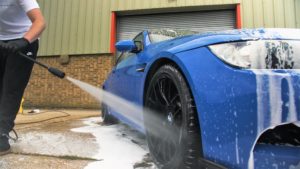
Getting asked ‘What is car detailing’ is something everybody in the industry would have come across, and distinguishing this from just washing, or valeting, your car is why we are here to explain the difference. After our quick guide, you will no longer need to ask the burning question.
Car Washing
That image you have in your head of the automatic car washes at your local garage, or the car washes where you park up and go do your shopping while the car gets hand washed, that exactly what a car wash is. A shampoo wash (Including wheels and tyres), a once over with a drying towel to stop water marks and streaks, and sometimes a spray wax. If you have paid for an upgrade, your car will get an inside vacuum as well.
Car Valeting
Car valeting is a step-up from your standard car wash, they offer different packages and can be a little more tailored to your specific needs. They tend to have a little more attention to detail and for a general vehicle user is a good enough job to clean the car inside and out.
When car valeting some of the products can often be a little slippery or oily, which is not great for your leather areas or steering wheel. If you pay for a top tier package, you will usually receive a polish of the paintwork and the windows cleaned inside and out. These packages can range from £35 up to around £75 but can sometimes be more depending on your location or company used.
Car Detailing
Often car valeting can be overlapped with detailing; Although if you wouldn’t believe it, detailing is more about going into the finer details and areas of the car. Treating each area with enough significance that it isn’t all done at once and can be completed on its own. Such as;
- Vehicle Cleaning: Cleaning with a snow foam or/and a citrus pre wash will loosen dirt and grease that may be on the car from general road use without having to lay a finger onto your vehicle paintwork. These are simply applied, allowing suitable contact time, then washed off. This would then be followed by a hand wash with a wash mitt (No sponges in sight!). Generally, a hand wash will adopt the two-bucket and grit guard method; one with your car shampoo, and the other with just clean water, cleaning with the shampoo and rinsing your wash mitt in the water bucket to rid of any dirt or grime before using the shampoo bucket again.
- Decontamination: Once the cleaning steps have been complete, you would decontaminate the vehicle with a fallout remover, removing metal contamination and brake dust from your vehicle, a tar & glue remover, removing tar and other hard to remove, sticky residues on your vehicle, then followed by a clay bar with a suitable lubricant, which will then further remove any deep contaminants in the paintwork, such as tree sap and overspray. Our advice is to feel your paint work before using any clay bar as if it is rough, then you haven’t done a good enough job in the hand wash. You wouldn’t want to rub this rough dirt into the paintwork with the bar.
- Wheels & Tyres: When cleaning wheels, detailers will typically take it one step further and remove the wheels from the car enabling them to get to the back to clean hard-to-reach areas. They will also clean up the brakes and inner components such as inner arch linings. Wheels can be cleaned being left on to the car, but it all depends on the detail and how much time you have.
Even with the wheels on the car, at the very least they will clean and decontaminate wheels using specialist products like our Evolution or Gyrate wheel cleaners and Nebula-X fallout remover. This would be aided by using a shampoo to help cover the wheel better and get into the tighter areas. Most chemical manufactures offer a wheel soap for this, however, this is a bit of a gimmick as a traditional car shampoo would do the exact same job. A true detailer will always brush-in the correct product for the specific type of wheel to remove grime and corrosive brake dust in every recess.
Once the tyres have been cleaned, removing dirt and old tyre dressings (we recommend an all-purpose cleaner orcitrus pre-wash) then dried, it would then be time to finish them off with a tyre dressing. Many detailers prefer to use a non-silicone based dressing for a matt finish, however, a silicone based dressing with look shinier and be more durable.
Polishing
Much like a valet, there are different tiers to a car detail. Depending on the level of detail you require, you may even decide to go down the compound route to further correct and perfect the paint finish. This may involve hand polishing, but most often will involve the use of a machine polisher (usually, a fixed rotary polisher will be used, but a dual action can be a bit gentler on thinner paint) – Not something we’d expect from DIY washers, but from detailers.
This system helps to remove any imperfections while polishing the paint’s surface, leaving a swirl-free finish. Machine polishers remove fine lines in paint, swirl marks and even orange peel, making the car look even better than when it left the factory. Both of our vehicle polishes leave an outstanding finish to your paintwork and contain carnauba wax.
Once all this is complete, a detailer will finish all paintwork with the application of a good wax or ceramic coating. This is not only to protect the work conducted, but also increase the longevity of the finish they have just spent so long on achieving.
Interior vacuuming and cleaning
On the inside detailers will vacuum all areas, as well as often using of a carpet shampoo to remove any stains. Other surfaces such as upholstery, trims and headlining, will also be cleaned and finished. They will often use special brushes or compressed air to clean any vents or dials found in the car. Windows and seals will also be attended to. Seats, whether leather or cloth, will be worked on with very specific products to the material. If leather, detailers often finish with a leather protector.
Engine bays
Engine bays will often be cleaned and finished when a vehicle has been sent to a detailer, making it the perfect finishing touch. They would usually use a degreaser for the cleaning of the bay, like our Frequency all-purpose cleaner, then finished with trim dressing like our product Axis can make any engine bay show worthy in a matter of minutes.
Finishing
Of course, there’s also a whole finishing process involved, a true detailer will use the correct product to finish and protect every surface, whether that’s restoring plastics with exterior plastic dressing, using an all-purpose polish to clean and protect door jambs, dressing tyres with a tyre creme, or simply making sure your windows are sparkling using a good glass cleaner. A real detailer deals with just that – the details.
In truth detailing is all about how far you want to ensure the longevity of your vehicle’s paintwork and lifespan of the exterior and interior areas. We want our customers to understand how and what products help with this and to what extent they should worry about the condition of their car and paint. Therefore, we are more than happy to discuss with individuals about their needs.
Get in touch with one of the Molecular team to chat about how we can help
Top 8 tips for vehicle detailing
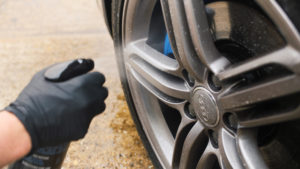
We’re here to give you 8 of our insights into what you should be doing when detailing your vehicle.
1. Don’t forget to snow foam/pre-wash:
Using a Snow Foam or Pre-Wash is the easiest and safest way to remove dirt, traffic film and grime from your vehicle. As these are spray on, wash off methods there is no need for any contact with the vehicle, reducing the chances of scratching the paintwork.
2. Make sure you’re using the right shampoo:
Fairy liquid is for washing your dishes, leave it in the kitchen. This type of soap is too harsh for your vehicles paintwork and will do more harm than good and will shorten the lifespan of your paintwork. Our vehicle shampoo is pH neutral and will not only just clean your vehicle, but they are safe to use on all protective coatings including waxes and ceramic.
3. Get a good wash mitt, don’t clean your car with a sponge:
We’ve all heard about washing your vehicle with a “bucket and sponge”, but is this the right thing to do? The answer is no, it’s not. Sponges will hold larger amount of grit and dirt as it has large pores. Once the grit is embedded in the sponge you might as well be using sandpaper. Using a wash mitt (usually a microfibre mitt) allows you to wash this grit and dirt off when you rinse it.
4. Use the 2 bucket method and grit guards:
We couldn’t recommend this method enough. It is absolutely vital that you adopt this method to avoid scratching your paintwork. One bucket should just have clean water in it. This is so you can wash your mitt in this bucket, removing all the grit and dirt off it before you submerge your mitt into the second bucket which will contain the shampoo. The grit guards inside both buckets will ensure that the dirt will sink to the bottom, meaning it won’t be floating around and attach to your clean wash mitt.
5. Find a good microfibre drying towel:
It is important to use a good, thick drying towel to avoid water marks/streaks left behind. The last thing you want when you have spent all that time cleaning your vehicle is to step back and find that your vehicle is covered in water marks because the towel you have been using has gotten wet too quickly. Another way to stop this is to use multiple towels, using a new one when the one you have used has become too wet.
6. Always clean up any overspray:
No matter if you are cleaning your dashboard, wheels, tyres, glass etc. it is important to ensure that any overspray that may have gone onto another surface has been cleared up. If you leave any overspray unattended and it dries on the surface, then it could potentially do serious damage to that surface. An easy way to avoid this is to spray the product you are using onto your cloth, sponge, brush etc. first and then applying to the area.
7. Brush your carpet as you are vacuuming:
Unfortunately, vacuuming your carpet alone won’t get all of the dirt out as they are hard wearing. Brush your carpet as you are vacuuming and watch as the dirt bounces up and get sucked away.
8. Don’t limit yourself to just 1 microfibre cloth:
If you are using a product that needs wiping then buffing, like our sparkle finishing detailing spray, don’t keep using the same 1 or 2 cloths. Ensure you change cloths once they become too wet to avoid any smearing or swirl marks.
Prepping your vehicle for winter
Preparing your car for winter may not even cross your mind, we’re a bit lucky that we don’t have too severe weather in the U.K to worry about, but it’s good practice just in case we do have a bad spell, here is our best tip for taking care of your paint over winter.
1.Check your tyres:
It is important to check your tyres, in all seasons not just winter, to ensure that you have enough tread to drive your vehicle legally. The legal limit for tyre treads is 1.6mm, however, the more you have, the easier it is for controlling steering and braking. We would recommend checking your tyres once a month.
2.Keep a close eye on your window wipers:
Checking your wipers is a very important thing to do because the last thing you want is wipers that don’t work properly in extreme weather conditions. Not only will the rubbers help remove the rain, snow, dust etc. but it will also stop the metal blades from scratching your glass.
3.Clean your windows, properly:
Having clean windows is vital because who likes to look through (or in!) dirty windows? Find yourself a good glass cleaner, like our Aurora glass cleaner, that will not only clean well, but will also not leave streaks behind. We would advise staying away from modern glass cleaners which claim to have “hydrophobic” or “beading” effects. These types of products are great for a little while, but once dirt starts sticking to it, your visibility will become very poor. Glass, when cleaned, will automatically produce a slight beading effect anyway without these products.
4.Keep on top of your screen wash:
You don’t need us to tell you, however, it is paramount that your vehicle screen wash is always topped up. Try to avoid cheap, ready to use supermarket ones as these can have very little alcohols in them, so when it comes to winter, they can freeze up and won’t come out. Our screen washes have a high percentage of these alcohols in them to not only help with the cleaning power, but to stop them from freezing.
5.Check the battery:
When the weather turns and gets colder, it can have an effect on your vehicle’s performance. Colder weather will have an impact on your vehicle’s battery, especially if you have had the same battery in it for some time. Home battery tests can be purchased from most motor retailers, as well as online. These give a good indication on how much “juice” is left in there. We recommend you ensure all controls are off (AC, heating, radio, heated seats etc.) and you warm the car up (turn the key a few times, not all the way that the engine starts) before starting your engine, and to carry jump leads in your boot just in case you need a jump start if broken down.
6.Check on your antifreeze:
Antifreeze does pretty much what is says it does. It stops the water in your engine’s cooling system from freezing. Antifreeze can be purchased from most supermarkets, along with your typical garage and motor shop. The antifreeze holding bottle is typically located underneath your bonnet next to your engine. If you are stuck or unsure where to locate it, always check your vehicles user manual.
